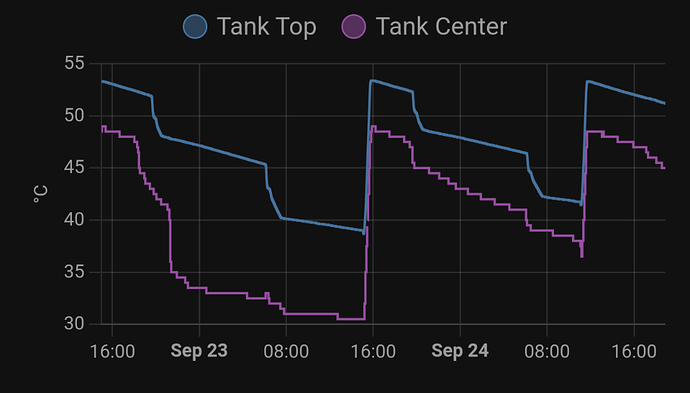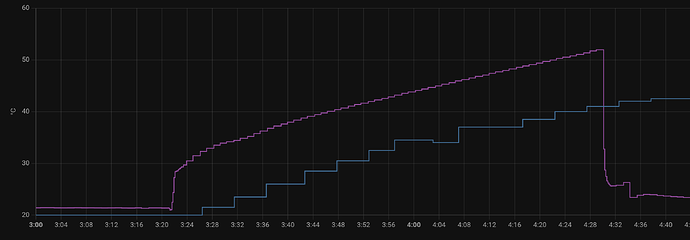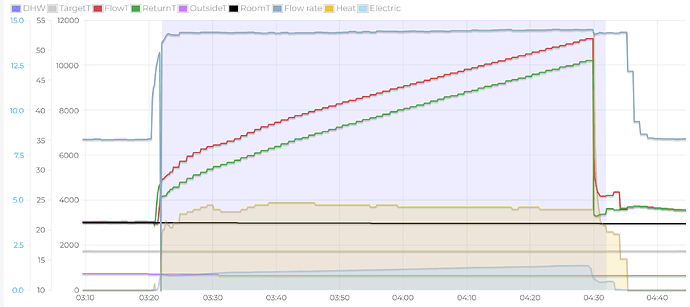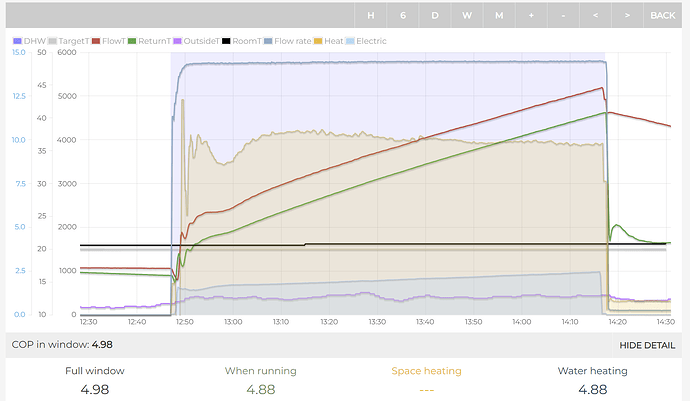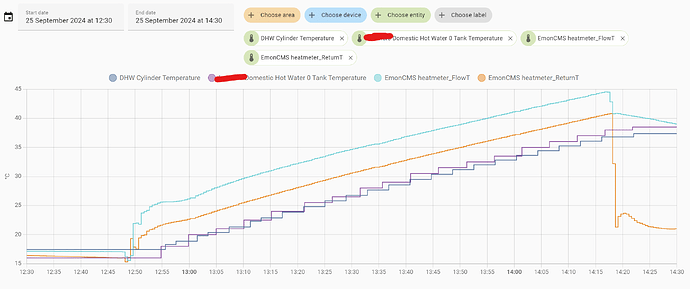Thanks Mick, André and Sarah for your very helpful and quick replies. It is reassuring, that things are not way off (comparing to André’s plot). To answer a few questions: the setpoint is 46, I need to check the flow rate this evening. My cylinder is a 250L McDonald STEELFlow using just the lower coil which is rated at 27kW and 2.96sqm surface area. I will read up on the hystereris setting, as suggested.
I have a Sunex Fish S15 300 X tank (300l), which comes with a 3.2 m² heat exchanger. Relative to tank volume, yours has a larger area so I think that should be fine.
I checked the DHW build pump setting and it is set to “Auto”. I can experiment with changing this. Is my logic correct that if I lower the flow rate, the flow temperature is likely to go down, as it will need a lower temperature to maintain a delta T between flow and return? One thing that I notice at the moment with the high flow rates that I am getting is that the water at the top of the tank is much higher than the set temperature (about 58 vs a set point of 46). I would expect it to be hotter, but it surprised me that it is so much hotter.
If I understand hysterisis correctly, since I am using timed heating cycles it should not impact too much, but I guess if I set it to a larger value, it will skip one of the heating cycles completely if I have not used much water; seems like a good change to make. I definitely take the point that I should get better COPs if I drain more of the hot water before doing DHW cycle.
A higher flow rate will give a smaller DT between flow and return.
Heat output is just maths where you can play with the figures.
Output = DT x SHC (4.2 for water) x flow rate
Mass flow calcs
https://docs.openenergymonitor.org/heatpumps/basics.html
What actual flow rate are you seeing in Auto? And what size Arotherm do you have? 3.5, 5, 7, 10 or 12?
Ultimately its the return temperature that dictates and satisfies the temperature probe to tell the hot water to stop.
The wider the DT, the higher the flow temp has to go reach the end goal.
ie. return temp + DT = flow temp.
BUT, cranking the flow rate up does come at an energy cost driving the pump harder, so there can be a downside to putting the DHW pump to 100%. But I wouldn’t stop you doing this just once or twice so you can see the result for yourself.
Ideally you want OEM or ebus to see all the stats though. You’re flying half blind at the moment.
On my arotherm it’s actually the tank sensor that stops the hot water cycle.
I believe that is the case for mine.
Yes, you’re both right.
What I meant is that the return temp will closely align with the target temp / probe temp when it stops.
The flow is just a result of return temp + DT.
if that makes sense?
I have a 7kW Arotherm Plus. I need to look to see what flow rates I am getting when the DHW cycle is running. As you say, I need better monitoring - thanks for the pointer to the eBus Adapter, I have one on order, so will be in a lot better position when it arrives. Then I can do some proper experiments!
From the discussion, I am reassured that there is nothing fundementally wrong with the way my heat pump is operating, but I am curious about a few things:
- the higher than expected temperature at the top of the tank (maybe this is my incorrect expectation)
- when I look at https://heatpumpmonitor.org/ it is interesting. Assuming that most people have a hot water set point around 45-48, then there seem to be two distinct modes of operation for the Arotherms: one set where the peak flow temp is about 62 and and one where it is about 52. Unfortunately I don’t have good evidence for this, but my strong impression is that mine was running at 52 peak and is now running at 62 peak, but I don’t know what changed!
Anyway, thanks for your advice. I will post anything interesting I find.
Hi Graham. What temperature did you expect, and what did you get?
It’s not unusual to see a tank top temperature 5degC above that at the tank base, at least during heating (in my experience, once DHW heating stops, conduction and convection reduce this difference to more like 2degC).
I am seeing about 58 degrees at the top of the tank when the temperature sensor (about 3/4 of the way down) is at 46 degrees. I haven’t been scientific in measuring this, but it seems to remain like that for a long time. That is what first prompted me to look at flow temperatures etc. I was noticing that the water coming out of the tap was noticeably hotter than I was expecting and thought the legionella cycle must have been running (but it hadn’t).
The coil is only in the bottom half of the tank. I am not quite sure what impact this has, but I can see that it makes sense to heat the cooler water and maybe it ends up quite stratified?
I’m definitely seeing larger deltas and barely any equilibration post heating cycle between top and center (more like bottom third) on my tank, but the offset @Plug1 is reporting is still significantly larger. Maybe the simplest explanation is that the center tank sensor has somehow lost proper thermal contact and is reporting too low temperatures, causing the DHW cycle to run longer? I have put generous amounts of thermal grease into those openings with the sensors to ensure good contact.
Good thought about poor sensor contact. I have a control stat pocket at the same level as the sensor pocket and I am able to get a reading with an IR thermometer, so I checked. It agrees with the sensor and I have some confidence in the IR reading as I have been able to calibrate and don’t appear to have any issues with emissivity. I also have a control stat pocket very near the top of the tank. At the moment I get 50 degrees at the top and 20 degrees at the bottom.
But I guess stratification like this should be good for efficiency!
EDIT: interestingly, last night it overshot and ended up with a temperature of 50.5 at the sensor and 61 at the top of the tank. I looked at the plots and wondered about whether the sensor has a problem, but in the end I decided that probably was not the most likely. In a stable state, it always seems to give reliable readings. I am more inclined to think it is complex fluid dynamics going on inside the tank. A pocket of slightly cooler water around the sensor, then some mixing and the controller suddenly reaslises that it has passed the set point? More guessing; I am not an expert in this!

It’s tough to say with the ~5 minute time resolution. My tank also overshoots at the end, but only by about 1-2°C and I see the compressor switch off the second the sensor has reached its target. What are those temperature drops you have halfway through the heating cycle? I assume that’s hot water use, so that adds some additional complex flow into the equation. Do you have example data without any use during the heating cycle?
I normally see behaviour like you describe with a small and consistent overshoot. In this case above, the pump switches off as soon as the temperature sensor reaches 46, but there is the strange dip. Extrapolating the first part of the curve to extend over the dip (I roughly drew this in the plot above), it looks like the temperature was probably increasing, but just not being measured. There was no hot water usage, as it was in the middle of the night. Also, the Vaillant Connect monitoring is slow (the 5 minute intervals you point out), but since the behaviour of the controller ties in with the temperature of the plot, I don’t think the monitoring is the fault.
My first thought is a faultly sensor, but this would seem to be a very unusual fault, as it seems OK the rest of the time. My second thought is weird fluid dynamics, but I don’t really know whether this is a possibility.
Interestingly, there is a striking similarity with a plot that @LeiChat posted a while ago: Vaillant Arotherm Owners Thread - #441 by LeiChat
As an additional datapoint: I turned down my flowrate for DHW to 60% today. At the end of the cycle (tank center at 47 °C) I got 62.4 °C flow, 56.4°C return i.e. a 6K dT with 22 l/min flow rate. At the full flow rate, I get 61.1 °C flow, 57.4°C return for a 3.7 K dT with 38l/min flow rate. Top of the tank was 53.3 °C with high and 53.6°C with low flow rate.
Find it interesting that everyone’s unit seems to behave a bit different. I’m guessing down to settings but who knows what’s making the difference it.
Mine for example cuts off with the flow temp just below the target tank temp (45C) at 44.6C. That’s in ECO mode, Auto pump (trying it out as it was set to 100 before). I thought I read that it cut out just below the tank target temp on purpose to let the last bit of heat soak in from the coil. Seems to have gotten a better COP using Auto pump speed than the 100% it was set to before. It’s the highest COP I’ve had for water heating (only been in 2-3 weeks) but I think the tank was also ‘one shower’ colder (there was basically no hot water in it), so that’s likely done it for me.
Having the pump at 100% vs Auto only seems to make 1C difference between the delta of flow and return too. ~2-3C on 100% and 4C on Auto. That’s 20lpm on 100% and 14lpm on Auto.
On the HA image, the two cylinder temps are one in the cylinder pocket of the Vaillant cylinder and one on the little holder by the immersion stat under the foam bit.
EDIT: OK analysis fail! I’ve just realised that it hit the 2hr limit for DWH and never actually got all the way to 45C is should have done ![]() The tank was colder than I’ve had it before and just assumed it had reached target temperature, I should have realised from the HA graphs that the cylinder temp was too low.
The tank was colder than I’ve had it before and just assumed it had reached target temperature, I should have realised from the HA graphs that the cylinder temp was too low.
This is really interesting! Yours stops when the flow temperature gets very close to the set point; not the tank temperature.
The other thing that is interesting is that the flow temperature seems a lot closer to the tank temperature through the cycle. I was noticing that half the vaillants on heatpumpmonitor.org seem to be like that and half have a bigger gap. I notice you say you have a Vaillant tank; I wonder whether that is the common theme - whether there is something different about the coil.
Analysis fail - seems it hit the 2hr time limit for DWH and stopped heating it. Because it was on a boost, it didn’t resume heating again making me think it had finished ![]() Only realised this morning when HA reported the tank temp was only 38C before I had a shower.
Only realised this morning when HA reported the tank temp was only 38C before I had a shower.
Setting the anti-cycle time to 0 removes the time limit.
